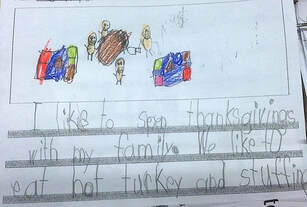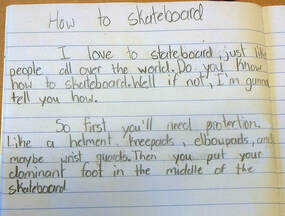|
Recently a teacher asked me if I could recommend a grammar workbook for a struggling reader and writer who was being instructed both in-class and remotely. The student’s mother, wanting to help her child learn grammar at home, was looking for an easy to use grammar workbook. My reply to the teacher and parent began with a confession: I’ve never taught grammar with a workbook. Thus, I had nothing to recommend. Rather than workbooks, I believe grammar is best taught through authentic writing and reading. [If anyone reading this blog who knows of research that says otherwise, please let me know! Seriously.] While there is certainly a time and place for some isolated skill practice, grammar can be effectively taught within the realm of authentic writing and reading tasks. And even when it does come time for some drill-the-skill, teachers and parents don’t need workbooks. Modeling plus sentence writing will do. In this post I hope to explain my philosophy of grammar instruction, beginning with standards, moving to instruction, and ending with authentic reading and writing activities that allow students to employ the grammar they are learning. I also hope to show that we can use common sense to figure out what grammar standards to really focus on. If all goes well, kids will deeply learn a handful of grammar concepts super useful for mastering writing and reading. First, Standards If you’re going to teach grammar without a workbook or basal literacy program, you will need a quality grammar scope and sequence. Grade level standards can be a starting point. I am most familiar with the Common Core national standards but any reputable state standards will do. With grade level standards in hand, reflect on the needs of the student/child. Pick the level that is most appropriate for your whole group, differentiated small group, or an individual. For example, if you are a parent with a fourth grader and you feel she is missing a fair number of 2nd grade concepts, then teach 2nd grade grammar standards. Don’t worry that the standards will be age-inappropriate. When lower grade standards are taught to upper grade children through authentic writing and reading tasks, the tasks automatically present the concepts in an age-appropriate way.  Next, condense, re-state, and prioritize the standards My belief is that in each grade level, there are only a handful of grammar concepts that are vital to learn (and therefore teach). The ones that are vital increase a child’s ability to write excellent sentences and paragraphs. Additionally, they contribute to reading fluency and comprehension. To make teaching manageable, look for standards that say pretty much the same thing and merge and condense them. At the same time, re-state the standards in ways that make sense and directly connect them to real world tasks, i.e. writing and reading! Finally, put less practical, rarely used standards aside for the time. Here’s an example of my process using five Common Core Grammar Standards, 5th Grade CCSS.ELA-LITERACY.L.5.1.A
Of these five, I think 1.B, 1.C, and 1.D say basically the same thing. Additionally, 1.E can be put aside – it just isn’t that important for day-to-day writing. What is important? Using conjunctive and prepositional phrases; writers use them all the time to effectively convey information, organize thoughts, and engage readers. Writers also need to correctly use verb tense. So, after merging, culling, and re-stating, I have these two standards to teach:
It will take students quite some time to master these two standards.and so I’ll want to teach them repeatedly and in a distributed way. BONUS: Click on the File Cabinet tab at the top of this page (next to the Blog tab), look at the top left hand column, and click on the PDF that says Grammar Standards Reimagined. It's an example of how I condense, re-state, and prioritize grammar standards, in this case all of the Common Core Grammar standards, 5th grade. The first two pages of the doc are the actual standards. The third and fourth pages show my take on the standards – merged, restated, prioritized, and now useful and do-able!  Next, teach the vital standards through genre writing Using grammar concepts helps students become better writers. Conversely, writing helps them better understand grammar. Therefore, have students practice grammar in writing! What types of writing? Why the three genres, of course: narrative, informational, and opinion/persuasion. For example, let’s imagine I want to teach a student to use prepositions to create phrases that give information and add interest. First, I’ll model the concept within narrative writing. I can also model it within informational writing. Here’s a narrative example (prepositional and conjunctive phrases are in italics). On the weekend, I enjoy riding my bike. When I first start, I peddle slowly. Later I whiz along. I ride on winding country roads, up and down hills and along flat fields. When the weather is warm, I ride for two or three hours. When I am done, I am tired but happy. Now informational: Who is the king of the solar system? Jupiter! Jupiter orbits between Mars and Saturn, far from the sun. It is the largest planet, much larger than Earth. In most places, you can easily see this planet without a telescope. Not long after the sun sets, look for a brilliant point of non-twinkling light just above the horizon. Don’t forget about reading After students write pieces, they should read them multiple times out loud. Students can read their writing to see how it sounds and to find mistakes. Reading aloud is also great for sharing, showing others what good writing sounds like, and general enjoyment. Also, grammar can and should be discussed and understood within the context books and articles. Therefore, read books and articles to and with students and as you read, discuss a grammar element. Here is my merged and rewritten Common Core Grammar standard (5th grade) that speaks to this:
Finally, remember what types of instruction are most effective In a nutshell, first model everything, then guide students as they practice, and finally allow students to practice independently (I do, we do, you do). Here’s a bit more detail on this:
In my next post, I’ll give a simple schedule a parent or teacher could use might do for grammar teaching for the week. Meanwhile, don’t forgot about the bonus document in the “File Cabinet.” Happy writing and reading! Comments are closed.
|
Mark WeaklandI am a teacher, literacy consultant, author, musician, nature lover, and life long learner.
|
 RSS Feed
RSS Feed